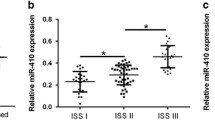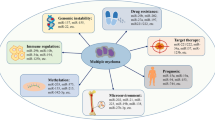Abstract
This study mainly explored the role of lncRNA miR503HG in multiple myeloma and the potential downstream regulatory mechanism affecting disease. Real-time quantitative polymerase chain reaction was used to measure the expression levels of miR503HG and miR-103. A cell counting kit-8 assay was performed to detect cell viability. The concentrations of adhesion-related factors (MUC-1, VCAM-1, ICAM-1) were determined using enzyme-linked immunosorbent assay. The targeting relationship between miR503HG and miR-103 was detected by dual-luciferase reporter assay. The miR503HG expression in peripheral blood of multiple myeloma patients was lower than that of normal healthy individuals and associated with ISS stage and worse overall survival. miR-103 was identified as the downstream target of miR503HG. Upregulation of miR503HG could inhibit cell proliferation and adhesion of multiple myeloma cell lines, which could partially reverse the inhibition of adhesion and proliferation by high expression of miR-103. lncRNA miR503HG expression was downregulated in multiple myeloma and had potential diagnostic/prognostic value. MiR503HG exerts a molecular sponge effect on miR-103 and affects its expression, thus achieving the inhibitory effect on multiple myeloma.




Similar content being viewed by others
References
Sun WJ, Zhang JJ, An N, Shen M, Huang ZX, Li X (2016) Clinical analysis of 40 multiple myeloma patients with extramedullary plasmacytoma of the head. J Int Med Res 44(6):1462–1473. https://doi.org/10.1177/0300060516664820
Spaan I, Raymakers RA, van de Stolpe A, Peperzak V (2018) Wnt signaling in multiple myeloma: a central player in disease with therapeutic potential. J Hematol Oncol 11(1):67. https://doi.org/10.1186/s13045-018-0615-3
Ge Q, Wang Y, Zhu H, Xu K, Sheng L, Yan X et al (2022) Gastrointestinal bleeding secondary to high-dose melphalan pretreatment in patients with multiple myeloma was associated with the mode of melphalan administration. Evid Based Complementary Altern Med 2022:2088217. https://doi.org/10.1155/2022/2088217
Bridges MC, Daulagala AC, Kourtidis A (2021) LNCcation: lncRNA localization and function. J Cell Biol. https://doi.org/10.1083/jcb.202009045
Fanelli GN, Gasparini P, Coati I, Cui R, Pakula H, Chowdhury B et al (2018) Long-Noncoding RNAs in gastroesophageal cancers. Non-coding RNA Res 3(4):195–212. https://doi.org/10.1016/j.ncrna.2018.10.001
Goyal B, Yadav SRM, Awasthee N, Gupta S, Kunnumakkara AB, Gupta SC (2021) Diagnostic, prognostic, and therapeutic significance of long non-coding RNA MALAT1 in cancer. Biochim Biophys Acta Rev Cancer 1875(2):188502. https://doi.org/10.1016/j.bbcan.2021.188502
Zhang D, Du D, Yi S, Li X (2020) LncRNA PCAT6: a potential biomarker for diagnosis and prognosis of bladder cancer. Ann Diagn Pathol 49:151642. https://doi.org/10.1016/j.anndiagpath.2020.151642
Zhang G, Fan E, Zhong Q, Feng G, Shuai Y, Wu M et al (2019) Identification and potential mechanisms of a 4-lncRNA signature that predicts prognosis in patients with laryngeal cancer. Hum Genomics 13(1):36. https://doi.org/10.1186/s40246-019-0230-6
Hu Y, Lin J, Fang H, Fang J, Li C, Chen W et al (2018) Targeting the MALAT1/PARP1/LIG3 complex induces DNA damage and apoptosis in multiple myeloma. Leukemia 32(10):2250–2262. https://doi.org/10.1038/s41375-018-0104-2
Gao Y, Fang P, Li WJ, Zhang J, Wang GP, Jiang DF et al (2020) LncRNA NEAT1 sponges miR-214 to regulate M2 macrophage polarization by regulation of B7–H3 in multiple myeloma. Mol Immunol 117:20–28. https://doi.org/10.1016/j.molimm.2019.10.026
Yang LH, Du P, Liu W, An LK, Li J, Zhu WY et al (2021) LncRNA ANRIL promotes multiple myeloma progression and bortezomib resistance by EZH2-mediated epigenetically silencing of PTEN. Neoplasma 68(4):788–797. https://doi.org/10.4149/neo_2021_210205N184
Tian J, Yang L, Wang Z, Yan H (2022) MIR503HG impeded ovarian cancer progression by interacting with SPI1 and preventing TMEFF1 transcription. Aging 14(13):5390–5405. https://doi.org/10.18632/aging.204147
Hu YL, Zhang YX, Liu N, Liu H, Yuan YC (2021) LncRNA MIR503HG regulated cell viability, metastasis and apoptosis of cervical cancer via miR-191/CEBPB axis. Eur Rev Med Pharmacol Sci 25(8):3200–3210. https://doi.org/10.26355/eurrev_202104_25728
Xu S, Zhai S, Du T, Li Z (2020) LncRNA MIR503HG inhibits non-small cell lung cancer cell proliferation by inducing cell cycle arrest through the downregulation of cyclin D1. Cancer Manag Res 12:1641–1647. https://doi.org/10.2147/cmar.S227348
Fu J, Dong G, Shi H, Zhang J, Ning Z, Bao X et al (2019) LncRNA MIR503HG inhibits cell migration and invasion via miR-103/OLFM4 axis in triple negative breast cancer. J Cell Mol Med 23(7):4738–4745. https://doi.org/10.1111/jcmm.14344
Li Z, Kumar S, ** DY, Calin GA, Chng WJ, Siu KL et al (2020) Epigenetic silencing of long non-coding RNA BM742401 in multiple myeloma: impact on prognosis and myeloma dissemination. J Clin Lab Anal 20:403. https://doi.org/10.1186/s12935-020-01504-4
**ao G, Li Y, Wang Y, Zhao B, Zou Z, Hou S et al (2018) LncRNA PRAL is closely related to clinical prognosis of multiple myeloma and the bortezomib sensitivity. Cancer Cell Int 370(2):254–263. https://doi.org/10.1016/j.yexcr.2018.06.026
Xu H, Yin Q, Shen X, Ju S (2020) Long non-coding RNA CCAT2 as a potential serum biomarker for diagnosis and prognosis of multiple myeloma. Ann Hematol 99(9):2159–2171. https://doi.org/10.1007/s00277-020-04161-9
Zhao P, Zhao X (2021) Baseline lncRNA PCAT1 high expression and its longitude increment during induction therapy predict worse prognosis in multiple myeloma patients. Ann Hematol 35(11):23924. https://doi.org/10.1002/jcla.23924
Zhong Y, Liu Z, Li D, Liao Q, Li J (2020) Identification and validation of a potential prognostic 7-lncRNA signature for predicting survival in patients with multiple myeloma. BioMed Res Int 2020:3813546. https://doi.org/10.1155/2020/3813546
Meng H, Han L, Hong C, Ding J, Huang Q (2018) Aberrant lncRNA expression in multiple myeloma. Oncol Res 26(5):809–816. https://doi.org/10.3727/096504017x15123872205507
Cho SF, Chang YC, Chang CS, Lin SF, Liu YC, Hsiao HH et al (2014) MALAT1 long non-coding RNA is overexpressed in multiple myeloma and may serve as a marker to predict disease progression. BMC Cancer 14:809. https://doi.org/10.1186/1471-2407-14-809
Liu N, Feng S, Li H, Chen X, Bai S, Liu Y (2020) Long non-coding RNA MALAT1 facilitates the tumorigenesis, invasion and glycolysis of multiple myeloma via miR-1271-5p/SOX13 axis. J Cancer Res Clin Oncol 146(2):367–379. https://doi.org/10.1007/s00432-020-03127-8
Ronchetti D, Todoerti K, Vinci C, Favasuli V, Agnelli L (2020) Expression pattern and biological significance of the lncRNA ST3GAL6-AS1 in multiple myeloma. Cancers. https://doi.org/10.3390/cancers12040782
Monteiro JP, Rodor J, Caudrillier A, Scanlon JP, Spiroski AM, Dudnakova T et al (2021) MIR503HG loss promotes endothelial-to-mesenchymal transition in vascular disease. Circ Res 128(8):1173–1190. https://doi.org/10.1161/circresaha.120.318124
Qiu F, Zhang MR, Zhou Z, Pu JX, Zhao XJ (2019) lncRNA MIR503HG functioned as a tumor suppressor and inhibited cell proliferation, metastasis and epithelial-mesenchymal transition in bladder cancer. J Cell Biochem 120(6):10821–10829. https://doi.org/10.1002/jcb.28373
Lin H, Wang J, Wang T, Wu J, Wang P, Huo X et al (2021) The LncRNA MIR503HG/miR-224-5p/TUSC3 signaling cascade suppresses gastric cancer development via modulating ATF6 branch of unfolded protein response. Front Oncol 11:708501. https://doi.org/10.3389/fonc.2021.708501
Han H, Li H, Zhou J (2020) Long non-coding RNA MIR503HG inhibits the proliferation, migration and invasion of colon cancer cells via miR-107/Par4 axis. J Cell Mol Med 395(2):112205. https://doi.org/10.1016/j.yexcr.2020.112205
Ren D, Cai Y, Xu G (2020) Potential of microRNA expression profile in predicting renal impairment risk in multiple myeloma patients. Transl Cancer Res 9(3):1495–1505. https://doi.org/10.21037/tcr.2020.01.41
Acknowledgements
Not applicable.
Funding
The authors did not receive support from any organization for the submitted work.
Author information
Authors and Affiliations
Corresponding authors
Ethics declarations
Conflict of interest
There is no conflict of interest in this study.
Additional information
Publisher's Note
Springer Nature remains neutral with regard to jurisdictional claims in published maps and institutional affiliations.
Rights and permissions
Springer Nature or its licensor (e.g. a society or other partner) holds exclusive rights to this article under a publishing agreement with the author(s) or other rightsholder(s); author self-archiving of the accepted manuscript version of this article is solely governed by the terms of such publishing agreement and applicable law.
About this article
Cite this article
Yin, P., Zhou, X. Potential Clinical Role of LncRNA miR503HG in Multiple Myeloma and its Effect on the Proliferation and Adhesion of Myeloma Cells. Indian J Hematol Blood Transfus 40, 43–51 (2024). https://doi.org/10.1007/s12288-023-01658-x
Received:
Accepted:
Published:
Issue Date:
DOI: https://doi.org/10.1007/s12288-023-01658-x




